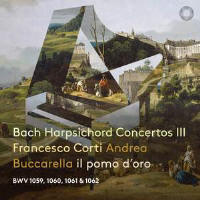Texte paru dans: / Appeared in: |
|
 |
Outil de traduction |
|
Having completed distinctive and imaginative recordings of Bach’s seven solo harpsichord concertos and Triple Concerto (7/20, 4/21), Francesco Corti moves on to the three concertos for two harpsichords. Of these, BWV1062 is better known in its original guise as the Double Violin Concerto, BWV1060 is better known in its popular putative reconstruction as a concerto for oboe and violin, and BWV1061 – the only one to have been specifically composed for harpsichords – simply deserves to be better known. Corti is joined on ‘Harpsichord 2’ by Andrea Buccarella, and a fine 20 fingers they make. Other than in places in BWV1060, Bach makes few distinctions between the parts, and with both players using copies by the same maker of the same 1738 Christian Vater instrument, there is no audible way of knowing who is who unless you happen to be following the score. So enjoyable is the music-making, however, that you’ll soon want to stop doing that and just listen. BWV1062 is fast and busy, making no attempt to imitate the lyricism of violins but pressing on and letting the transparent textures – the evervibrant Il Pomo d’Oro are here single strings – speak for themselves. Terse string chords in the finale will make you think of CPE Bach. By contrast, BWV1060 opens at a steadier speed than you might expect, its pulse a gentle squeeze. It’s a pity that the string halo that accompanies the soloists in the slow movement at 3'09" is almost inaudible, but the finale is a clamorous, brilliant finish, full of bubbling keyboard figuration (dare I say faster than an oboe might comfortably go?) and eager tutti responses. BWV1061, in which the string parts are so subservient as to be barely necessary, is a real celebration of keyboard brilliance and gets an exuberant outing, full of joyful drive in the fast movements and good honest expressive rubato in the slower. As a bonus, Corti fashions his own ‘creative reconstruction’ of a concerto for harpsichord, oboe and strings, BWV1059, which Bach began to copy out but left off after nine bars, enough to show that it was going to be based on the opening movement for organ and orchestra of Cantata No 35. The remaining movements Corti adapts from later numbers in that work: a siciliana-like aria (the oboe takes the singer’s line), and a second orchestral movement with organ. He says he had to thin out the notes in places and invent new ones in others, mainly for reasons of balance and tone sustenance, but no one who has heard his recent richly inventive Handel Suites (Arcana, 5/22) would be surprised to learn that he manages these textures with convincing ease.
|
|




